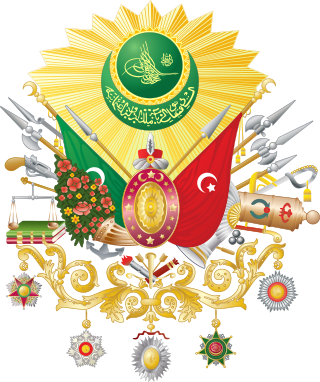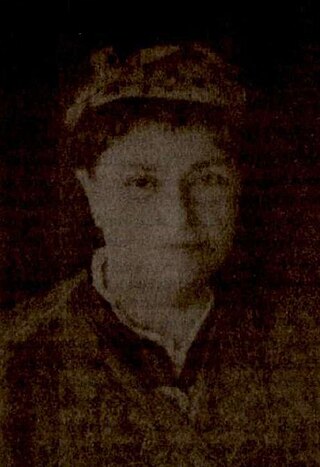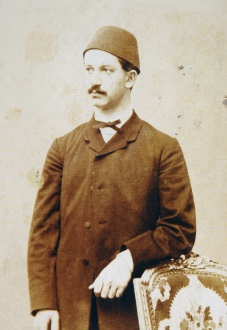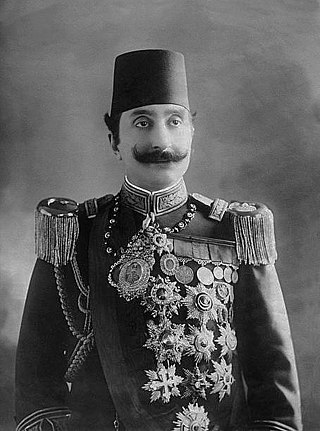
The Tomb of Abdul Hamid I (Turkish : I. Abdülhamid Türbesi) is the final resting place of Ottoman Sultan Abdul Hamid I located at Fatih in Istanbul, Turkey. [1]

The Tomb of Abdul Hamid I (Turkish : I. Abdülhamid Türbesi) is the final resting place of Ottoman Sultan Abdul Hamid I located at Fatih in Istanbul, Turkey. [1]
The tomb is situated on the corner of Hamidiye St. and Hamidiye Türbesi St. in Eminönü quarter of Fatih district in Istanbul. [2] It was built for Sultan Abdul Hamid I (reigned 1774–1789) in 1790 by court architect Mehmed Tahir Agha as part of a 1776–1777 constructed almshouse complex. [1] The tomb contains 20 sarcophagi in total. [3] In addition to Abdul Hamid I, his assassinated son Sultan Mustafa IV (r. 1807–1808) rests in the tomb. Other occupants of the tomb are shahzadehs and sultanas, namely princes, princesses and consorts as relatives of the sultans. [1]
The tomb building was designed in square-plan with rounded corners in Baroque style, and constructed completely in fine marbles. Austrian orientalist and historian Joseph von Hammer-Purgstall (1774–1856) praised the architecture of the tomb in his memoirs as worth seeing. [1]
An inscription showing the 27th–30th āyāt of the Quranic surah Al-Fajr in thuluth calligraphy handwritten by Mehmed Emin is situated above the entrance gate of the tomb. The tomb's external appearance shows it as a two-story building with a wide molding cornice separating the floors. A done tops the structure. There are 26 windows in two rows around the building, which enable brightness in the interior. The script inside the medallion at the dome interior reads as "Oh! You, who know my status. I only trust in You, I take refuge in You" (Ottoman Turkish : Ya alimen bi-hali aleyke ittikali). The scripts of the medallions inside the dome carrying pendant vaults are "Ism-i Jalal", "Ism-i Nebi", "Chehar yar-i Güzin" and "Hasan and Husayn", the attributes of Allah, Muhammad, the first four caliphs and Hasan-Husayn respectively. The tomb's interior is decorated with carvings. On the northern wall, a marble panel with Qadam Rasul, footprint of the Prophet, is attached. A marble belt with Al-Mulk surah handwritten in thuluth script surround the interior. [1]
The tomb was opened to public visit in August 2009 after completion of restoration works. [3]

Abdulhamid I or Abdul Hamid I was the 27th sultan of the Ottoman Empire from 1774 to 1789.

Mustafa III was the sultan of the Ottoman Empire from 1757 to 1774. He was a son of Sultan Ahmed III (1703–30), and his consort Mihrişah Kadın. He was succeeded by his brother Abdul Hamid I (1774–89).

Mustafa IV was the sultan of the Ottoman Empire from 1807 to 1808.

Fatih is a municipality and district of Istanbul Province, Turkey. Its area is 15 km2, and its population is 368,227 (2022). It is home to almost all of the provincial authorities but not the courthouse. It encompasses the historical peninsula, coinciding with old Constantinople. In 2009, the district of Eminönü, which had been a separate municipality located at the tip of the peninsula, was once again remerged into Fatih because of its small population. Fatih is bordered by the Golden Horn to the north and the Sea of Marmara to the south, while the Western border is demarked by the Theodosian wall and the east by the Bosphorus Strait.

The Zeynep Sultan Mosque is a mosque in Istanbul, Turkey. It was built in 1769 by Ayazma Mosque's architect Mehmet Tahir Ağa for Ahmed III's daughter Zeynep Sultan. It evokes Byzantine churches because of its architectural style and materials that were used in its construction.

The New Mosque and later New Valide Sultan Mosque after its partial reconstruction and completion between 1660 and 1665, is an Ottoman imperial mosque located in the Eminönü quarter of Istanbul, Turkey. It is situated on the Golden Horn, at the southern end of the Galata Bridge, and is a notable Istanbul landmark marking the crossing from the old historic core of the city to the Beyoğlu (Pera) district. The mosque is a notable example of the Sultanate of Women period in Ottoman Empire.

Abdulhamid II or Abdul Hamid II was the 34th sultan of the Ottoman Empire, from 1876 to 1909, and the last sultan to exert effective control over the fracturing state. He oversaw a period of decline with rebellions, and presided over an unsuccessful war with the Russian Empire (1877–78), the loss of Egypt and Cyprus from Ottoman control, followed by a successful war against the Kingdom of Greece in 1897, though Ottoman gains were tempered by subsequent Western European intervention.
Esma Sultan was an Ottoman princess, the daughter of Sultan Abdulaziz and Gevheri Kadın.

Rabia Şermi Kadın was a consort of Sultan Ahmed III and the mother of Sultan Abdulhamid I.

Osmanoğlu is a family belonging to the historical Ottoman dynasty, which was the ruling house of the Ottoman Empire from 1299 until the abolition of the Ottoman sultanate in 1922, and the Ottoman Caliphate from 1517 until the abolition of the caliphate in 1924. In 1924, members of the Osmanoğlu family were forced into exile. Their descendants now live in many countries throughout Europe, as well as in the United States, the Middle East, and since they have now been permitted to return to their homeland, many now also live in Turkey. The female members of the dynasty were allowed to return after 1951, and the male members after 1973. The family adopted the surname of Osmanoğlu, meaning "son of Osman".

The Istanbul 4th Vakıf Han is a historical large office building located in the Sirkeci neighbourhood of the Eminönü quarter within the Fatih district of Istanbul, Turkey. It is owned by the Foundations Administration. Currently, it is used as a five star hotel of the World Park Hotel chain named Legacy Ottoman.

Pesend Hanım was a consort of Sultan Abdul Hamid II of the Ottoman Empire.

Bedrifelek Kadın was the third consort of Sultan Abdul Hamid II of the Ottoman Empire.

Şehzade Ahmed Kemaleddin Efendi was an Ottoman prince, son of Sultan Abdulmejid I and his consort Verdicenan Kadın.

Emirgan Mosque, officially Emirgan Hamid-i Evvel Mosque is an 18th-century Ottoman mosque located in the Emirgan neighborhood of the Sarıyer district in Istanbul, Turkey.

Şehzade Mehmed Selim Efendi was an Ottoman prince, the eldest son of Sultan Abdul Hamid II and his consort Bedrifelek Kadın.

The Tomb of Turhan Sultan is the mausoleum of five Ottoman sultans, located at Fatih in Istanbul, Turkey. It was built in 1663 for Turhan Sultan, first Haseki of Sultan Ibrahim and mother of Sultan Mehmed IV.
Fatma Şebsefa Kadın was a consort of Sultan Abdul Hamid I of the Ottoman Empire.

Ottoman Baroque architecture, also known as Turkish Baroque, was a period in Ottoman architecture in the 18th century and early 19th century which was influenced by European Baroque architecture. Preceded by the changes of the Tulip Period and Tulip Period architecture, the style marked a significant departure from the classical style of Ottoman architecture and introduced new decorative forms to mostly traditional Ottoman building types. It emerged in the 1740s during the reign of Mahmud I (1730–1754) and its most important early monument was the Nuruosmaniye Mosque, completed in 1755. Later in the 18th century, new building types were also introduced based on European influences. The last fully Baroque monuments, such as the Nusretiye Mosque, were built by Mahmud II in the early 19th century, but during this period new European-influenced styles were introduced and supplanted the Baroque.

The Beylerbeyi Mosque, also known as the Hamid i-Evvel Mosque, is a mosque located in the Beylerbeyi neighbourhood in Istanbul, Turkey. It was first built in 1777–1778 by the Ottoman sultan Abdülhamid I, but was later modified by Mahmud II in 1820–1821.
41°00′55.8″N28°58′26.9″E / 41.015500°N 28.974139°E